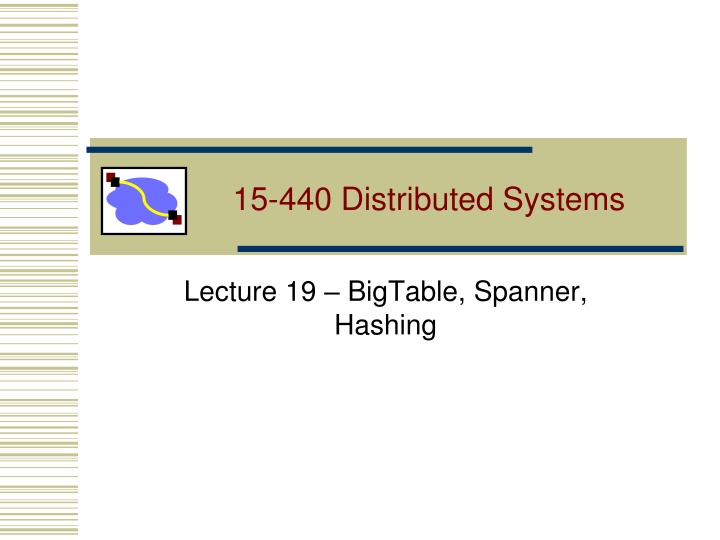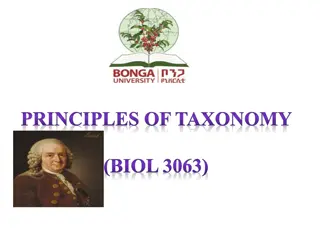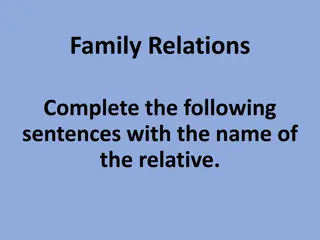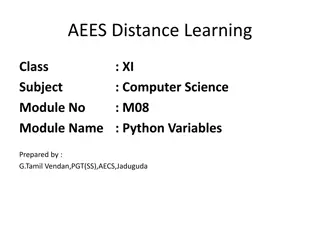
Distributed Systems: BigTable, Spanner, and Hashing Overview
Explore the architecture and features of BigTable, Spanner, and hashing in distributed systems. Learn about the design, scalability, and uses of these technologies at Google, offering insights into managing large-scale structured data efficiently.
Download Presentation

Please find below an Image/Link to download the presentation.
The content on the website is provided AS IS for your information and personal use only. It may not be sold, licensed, or shared on other websites without obtaining consent from the author. If you encounter any issues during the download, it is possible that the publisher has removed the file from their server.
You are allowed to download the files provided on this website for personal or commercial use, subject to the condition that they are used lawfully. All files are the property of their respective owners.
The content on the website is provided AS IS for your information and personal use only. It may not be sold, licensed, or shared on other websites without obtaining consent from the author.
E N D
Presentation Transcript
15-440 Distributed Systems Lecture 19 BigTable, Spanner, Hashing
Overview BigTable Spanner Hashing Tricks 2
BigTable Distributed storage system for managing structured data. Designed to scale to a very large size Petabytes of data across thousands of servers Used for many Google projects Web indexing, Personalized Search, Google Earth, Google Analytics, Google Finance, Flexible, high-performance solution for all of Google s products 3
Motivation Lots of (semi-)structured data at Google URLs: Contents, crawl metadata, links, anchors, pagerank, Per-user data: User preference settings, recent queries/search results, Geographic locations: Physical entities (shops, restaurants, etc.), roads, satellite image data, user annotations, Scale is large Billions of URLs, many versions/page (~20K/version) Hundreds of millions of users, thousands or q/sec 100TB+ of satellite image data 4
Basic Data Model A BigTable is a sparse, distributed persistent multi-dimensional sorted map (row, column, timestamp) cell contents Good match for most Google applications 5
WebTable Example Want to keep copy of a large collection of web pages and related information Use URLs as row keys Various aspects of web page as column names Store contents of web pages in the contents: column under the timestamps when they were fetched. Anchors: is a set of links that point to the page 6
Rows Name is an arbitrary string Access to data in a row is atomic Row creation is implicit upon storing data Rows ordered lexicographically Rows close together lexicographically usually on one or a small number of machines 7
Columns Columns have two-level name structure: family:optional_qualifier Column family Unit of access control Has associated type information Qualifier gives unbounded columns Additional levels of indexing, if desired 9
Timestamps Used to store different versions of data in a cell New writes default to current time, but timestamps for writes can also be set explicitly by clients Lookup options: Return most recent K values Return all values in timestamp range (or all values) Column families can be marked w/ attributes: Only retain most recent K values in a cell Keep values until they are older than K seconds 10
Servers Tablet servers manage tablets, multiple tablets per server. Each tablet is 100-200 MB Each tablet lives at only one server Tablet server splits tablets that get too big Master responsible for load balancing and fault tolerance 13
Tablet Contains some range of rows of the table Built out of multiple SSTables Start:aardvark End:apple Tablet SSTable SSTable 64K block 64K block 64K block 64K block 64K block 64K block Index Index 14
SSTable Immutable, sorted file of key-value pairs Chunks of data plus an index Index is of block ranges, not values SSTable 64K block 64K block 64K block Index 16
Table Multiple tablets make up the table SSTables can be shared Tablets do not overlap, SSTables can overlap Tablet aardvark Tablet apple_two_E apple boat SSTable SSTable SSTable SSTable 17
Tablet Location Since tablets move around from server to server, given a row, how do clients find the right machine? Need to find tablet whose row range covers the target row 18
Chubby {lock/file/name} service Coarse-grained locks, can store small amount of data in a lock 5 replicas, need a majority vote to be active Uses Paxos 19
Editing a table Mutations are logged, then applied to an in-memory memtable May contain deletion entries to handle updates Group commit on log: collect multiple updates before log flush Tablet Memtable Insert Insert Delete Memory boat apple_two_E tablet log Insert Delete SSTable SSTable GFS Insert 21
Compactions Minor compaction convert the memtable into an SSTable Reduce memory usage Reduce log traffic on restart Merging compaction Reduce number of SSTables Good place to apply policy keep only N versions Major compaction Merging compaction that results in only one SSTable No deletion records, only live data 23
Overview BigTable Spanner Hashing Tricks 24
What is Spanner? Distributed multiversion database General-purpose transactions (ACID) SQL query language Schematized tables Semi-relational data model Running in production Storage for Google s ad data Replaced a sharded MySQL database OSDI 2012 25
Example: Social Network Sao Paulo Santiago Buenos Aires x1000 San Francisco Seattle Arizona Brazil x1000 User posts User posts User posts User posts User posts Friend lists Friend lists Friend lists Friend lists Friend lists Moscow Berlin Krakow London Paris Berlin Madrid Lisbon US x1000 x1000 Russia Spain OSDI 2012 26
Read Transactions Generate a page of friends recent posts Consistent view of friend list and their posts Why consistency matters 1. Remove untrustworthy person X as friend 2. Post P: My government is repressive OSDI 2012 27
Single Machine Block writes Generate my page Friend1 post Friend2 post User posts Friend lists Friend lists User posts Friend999 post Friend1000 post OSDI 2012 28
Multiple Machines Block writes User posts Friend lists Friend lists User posts Friend1 post Friend2 post Generate my page Friend999 post User posts Friend lists Friend lists User posts Friend1000 post OSDI 2012 29
Multiple Datacenters User posts Friend lists Friend1 post US x1000 User posts Friend lists Friend2 post Spain x1000 Generate my page User posts Friend lists Friend999 post x1000 Brazil User posts Friend lists Friend1000 post Russia x1000 OSDI 2012 30
Version Management Transactions that write use strict 2PL Each transaction T is assigned a timestamp s Data written by T is timestamped with s Time <8 8 15 [X] [] My friends [P] My posts X s friends [me] [] OSDI 2012 31
Synchronizing Snapshots Global wall-clock time == External Consistency: Commit order respects global wall-time order == Timestamp order respects global wall-time order given timestamp order == commit order OSDI 2012 32
Timestamps, Global Clock Strict two-phase locking for write transactions Assign timestamp while locks are held Acquired locks Release locks T Pick s = now() OSDI 2012 33
TrueTime Global wall-clock time with bounded uncertainty TT.now() time earliest latest 2* OSDI 2012 34
Timestamps and TrueTime Acquired locks Release locks T Pick s = TT.now().latest s Wait until TT.now().earliest > s Commit wait average average OSDI 2012 35
Summary GFS/HDFS Data-center customized API, optimizations Append focused DFS Separate control (filesystem) and data (chunks) Replication and locality Rough consistency apps handle rest BigTable Built on top of GFS, Chubby, etc. Similar master/storage split Use memory + log for speed Motivated range of work into non-SQL databases Spanner Globally distributed, and synchronously-replicated database Uses time sync and some slowdown to get consistency 36
Overview BigTable Spanner Hashing Tricks 37
Hashing Two uses of hashing that are becoming wildly popular in distributed systems: Content-based naming Consistent Hashing of various forms
Example systems that use them BitTorrent & many other modern p2p systems use content-based naming Content distribution networks such as Akamai use consistent hashing to place content on servers Amazon, Linkedin, etc., all have built very large- scale key-value storage systems (databases--) using consistent hashing
Dividing items onto storage servers Option 1: Static partition (items a-c go there, d-f go there, ...) If you used the server name, what if cowpatties.com had 1000000 pages, but zebras.com had only 10? Load imbalance Could fill up the bins as they arrive Requires tracking the location of every object at the front-end.
Hashing 1 Let nodes be numbered 1..m Client uses a good hash function to map a URL to 1..m Say hash (url) = x, so, client fetches content from node x No duplication not being fault tolerant. Any other problems? What happens if a node goes down? What happens if a node comes back up? What if different nodes have different views? 41
Option 2: Conventional Hashing bucket = hash(item) % num_buckets Sweet! Now the server we use is a deterministic function of the item, e.g., sha1(URL) 160 bit ID % 20 a server ID But what happens if we want to add or remove a server?
Option 2: Conventional Hashing Let 90 documents, node 1..9, node 10 which was dead is alive again % of documents in the wrong node? 10, 19-20, 28-30, 37-40, 46-50, 55-60, 64-70, 73-80, 82-90 Disruption coefficient = 43
Consistent Hash view = subset of all hash buckets that are visible Desired features Balanced in any one view, load is equal across buckets Smoothness little impact on hash bucket contents when buckets are added/removed Spread small set of hash buckets that may hold an object regardless of views Load across all views # of objects assigned to hash bucket is small 44
Consistent Hash Example Construction Assign each of C hash buckets to random points on mod 2n circle, where, hash key size = n. Map object to random position on circle Hash of object = closest clockwise bucket 0 14 Bucket 4 12 8 Smoothness addition of bucket does not cause much movement between existing buckets Spread & Load small set of buckets that lie near object Balance no bucket is responsible for large number of objects 45
Hashing 2: For naming Many file systems split files into blocks and store each block on a disk. Several levels of naming: Pathname to list of blocks Block #s are addresses where you can find the data stored therein. (But in practice, they re logical block #s the disk can change the location at which it stores a particular block... so they re actually more like names and need a lookup to location :)
A problem to solve... Imagine you re creating a backup server It stores the full data for 1000 CMU users laptops Each user has a 100GB disk. That s 100TB and lots of $$$ How can we reduce the storage requirements?
Deduplication A common goal in big archival storage systems. Those 1000 users probably have a lot of data in common -- the OS, copies of binaries, maybe even the same music or movies How can we detect those duplicates and coalesce them? One way: Content-based naming, also called content-addressable foo (storage, memory, networks, etc.) A fancy name for...
Name items by their hash Imagine that your filesystem had a layer of indirection: pathname hash(data) hash(data) list of blocks For example: /src/foo.c -> 0xfff32f2fa11d00f0 0xfff32f2fa11d00f0 -> [5623, 5624, 5625, 8993] If there were two identical copies of foo.c on disk ... We d only have to store it once! Name of second copy can be different
A second example Several p2p systems operate something like: Search for national anthem , find a particular file name (starspangled.mp3). Identify the files by the hash of their content (0x2fab4f001...) Request to download a file whose hash matches the one you want Advantage? You can verify what you got, even if you got it from an untrusted source (like some dude on a p2p network)
P2P-enabled Applications: Self-Certifying Names Name = Hash(pubkey, salt) Value = <pubkey, salt, data, signature> can verify name related to pubkey and pubkey signed data Can receive data from caches, peers or other 3rd parties without worry 51
Hash functions Given a universe of possible objects U, map N objects from U to an M-bit hash. Typically, |U| >>> 2M. This means that there can be collisions: Multiple objects map to the same M-bit representation. Likelihood of collision depends on hash function, M, and N. Birthday paradox roughly 50% collision with 2M/2 objects for a well designed hash function






















